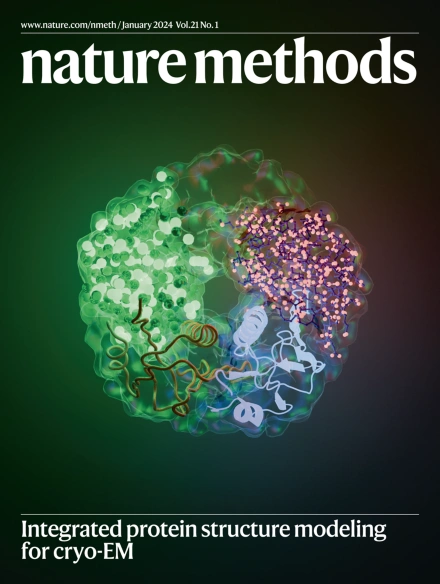CLEM-Reg: an automated point cloud-based registration algorithm for volume correlative light and electron microscopy
IF 32.1
1区 生物学
Q1 BIOCHEMICAL RESEARCH METHODS
引用次数: 0
Abstract
Volume correlative light and electron microscopy (vCLEM) is a powerful imaging technique that enables the visualization of fluorescently labeled proteins within their ultrastructural context. Currently, vCLEM alignment relies on time-consuming and subjective manual methods. This paper presents CLEM-Reg, an algorithm that automates the three-dimensional alignment of vCLEM datasets by leveraging probabilistic point cloud registration techniques. Point clouds are derived from segmentations of common structures in each modality, created by state-of-the-art open-source methods. CLEM-Reg drastically reduces the registration time of vCLEM datasets to a few minutes and achieves correlation of fluorescent signal to submicron target structures in electron microscopy on three newly acquired vCLEM benchmark datasets. CLEM-Reg was then used to automatically obtain vCLEM overlays to unambiguously identify TGN46-positive transport carriers involved in protein trafficking between the trans-Golgi network and plasma membrane. Datasets are available on EMPIAR and BioStudies, and a napari plugin is provided to aid end-user adoption. CLEM-Reg automates the three-dimensional alignment of volume correlative light and electron microscopy datasets by leveraging probabilistic point cloud registration techniques for fast and accurate results across diverse datasets.

CLEM-Reg:一种基于自动点云的体相关光学和电子显微镜配准算法。
体积相关光和电子显微镜(vCLEM)是一种强大的成像技术,可以在其超微结构背景下可视化荧光标记的蛋白质。目前,vCLEM对齐依赖于耗时且主观的人工方法。本文介绍了CLEM-Reg算法,该算法利用概率点云配准技术自动对vCLEM数据集进行三维对齐。点云来源于每个模态的公共结构的分割,由最先进的开源方法创建。CLEM-Reg将vCLEM数据集的配准时间大幅缩短至几分钟,并在三个新获得的vCLEM基准数据集上实现了荧光信号与亚微米目标结构的电子显微镜相关。然后使用CLEM-Reg自动获得vCLEM覆盖,以明确识别参与反式高尔基网络和质膜之间蛋白质运输的tgn46阳性转运载体。数据集可在EMPIAR和BioStudies上获得,并提供了napari插件以帮助最终用户采用。
本文章由计算机程序翻译,如有差异,请以英文原文为准。
求助全文
约1分钟内获得全文
求助全文
来源期刊

Nature Methods
生物-生化研究方法
CiteScore
58.70
自引率
1.70%
发文量
326
审稿时长
1 months
期刊介绍:
Nature Methods is a monthly journal that focuses on publishing innovative methods and substantial enhancements to fundamental life sciences research techniques. Geared towards a diverse, interdisciplinary readership of researchers in academia and industry engaged in laboratory work, the journal offers new tools for research and emphasizes the immediate practical significance of the featured work. It publishes primary research papers and reviews recent technical and methodological advancements, with a particular interest in primary methods papers relevant to the biological and biomedical sciences. This includes methods rooted in chemistry with practical applications for studying biological problems.
 求助内容:
求助内容: 应助结果提醒方式:
应助结果提醒方式:


